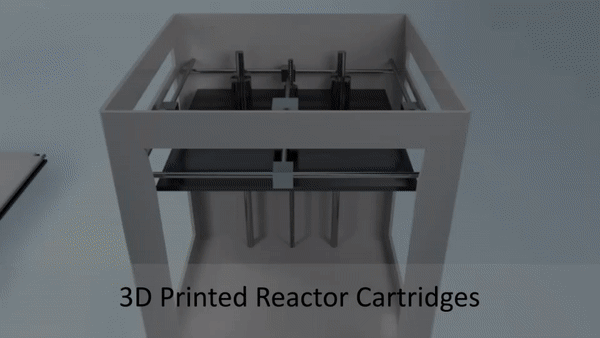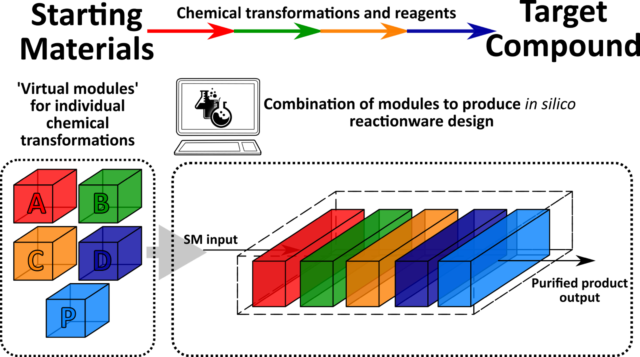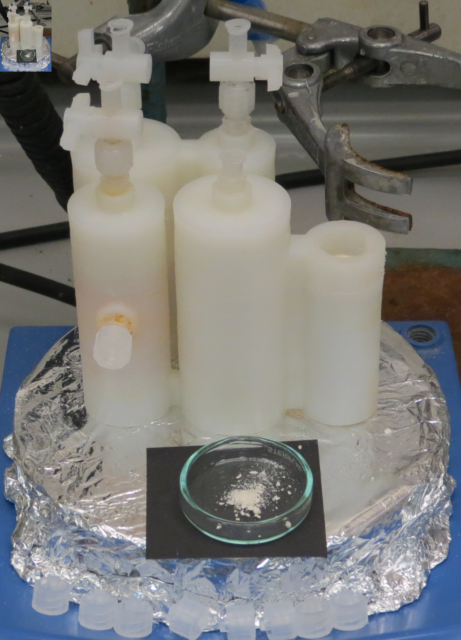Drug Factory in your Pocket: synthesis for the 21st century

Obsolescence due to technological advances is not a new idea; in the early 2000’s, the rise of e-books became prevalent thanks to Jeff Bezos and the Kindle bookstore on Amazon. His idea was simple: “paperbacks go out of print, e-books don’t”. With this model, he developed the world’s largest repository of digital books, available for anyone to read, buy and share their favourite books from the comfort of their own home, creating a global digital library for the 21st century.
An intriguing question: can we do the same for manufacturing and distributing important drugs, so that on-demand drugs can become as widely available as e-books?
The answer: Yes we can! Using Reactionware.
So, what is Reactionware and why should you care? Simply put, our lab’s invention of Reactionware represents a development in the way we can synthesise and distribute molecules to the masses using on-demand 3D printed technologies. It comprises of a system of cartridges printed using polypropylene, a common household plastic, which connect together, like LEGO, to create discrete monoliths that allow for quick and easy synthesis of important drugs, such as Ribavirin (hepatitis C treatment), Modafinil (narcolepsy treatment) and Baclofen (a muscle relaxant), to name just a few.

The reasons for wanting to use Reactionware for synthesis over traditional glassware methods are four-fold:
- Ease of synthesis: synthesis is an art form, often taking years to master. With Reactionware, it becomes a simpler task, making complex synthesis more accessible.
- Money & time saved: For drug manufacturers, the cost and time benefits associated with using Reactionware, in addition to far superior reproducibility, make it much more viable compared to traditional batch methods.
- Digitisation: Shifting the paradigm from traditional chemistry using glassware to the digital era using Reactionware means syntheses for important drugs never go “out of date”, just as e-books have done for paperbacks.
- Improved availability: Allows for drug synthesis on-demand in countries where demand outstrips supply and makes the process easy for chemists and non-chemists alike. However, it should be understood this technology would need to be heavily regulated to prevent the manufacture of illegal drugs by non-chemists who would seek to exploit this technology.
As a proof-of-concept, we have recently produced the complex molecule, Baclofen. We manufactured this by exposing readily available simple molecules to a series of chemical transformations (like when using a simple recipe to bake a cake from a series of ingredients) and by only using a three-step process, compared to the far longer six to eight-step traditional batch process. These both highlight the major utility of Reactionware as a platform for on-demand drug synthesis as it can be used to make complex molecules using simple steps (a short procedure) in a closed and compartmentalised, easily printable monolithic system. Essentially, Reactionware can be considered a modern example of continuous processing, which utilises fewer resources and offers far greater flexibility for the reasons outlined above when compared with the traditional batch processing approach1.

The originality of the Reactionware approach displays two key benefits over traditional manufacturing. First, it combines several processing steps including, for example, four reactions, two liquid-liquid extractions, and a set of evaporations and filtrations inside one tailor-made reactor device containing several interconnected modules. Second, said device can be printed on demand for use in a distributed setting. Considering these important benefits, the utility of Reactionware can be adapted not only to different applications but also locations, making it a possible solution for combating the rising cost of global pharmaceutical R&D and manufacturing.
A recent endorsement of Reactionware by Christian Hornung, an Australian chemical engineering researcher stated that: “by demonstrating the multistep synthesis of baclofen in this integrated, benchtop device, the door has been opened to making complex molecules, such as APIs [Active Pharmaceutical Ingredients], on demand in non-traditional manufacturing environments such as hospitals or even doctors’ offices, bringing manufacturing closer to the point of use.” The importance of this should not be understated as this will result in lower human error in transport, cheaper transport costs and increased availability due to a reduced travel distance. Beyond hospitals and research labs, manufacturing scenarios might also include remote settings, synthesis of personalised medicines, small-scale production of abandoned pharmaceuticals or even space missions.
Of course, in order for this technology to be put into practice, a range of regulatory hurdles would have to be overcome, including the approach to quality control and chemical analysis in remote settings and the cost of remote on-demand synthesis compared with shipping, storage and inventory of traditionally manufactured drugs. This is substantiated by recent UK Parliamentary statistics for overall R&D spending, with £4.5 billion being spent on pharmaceutical R&D, representing more than ⅓ of the total yearly spend for 2019. By utilising Reactionware as an alternative to traditional R&D methods, we could envisage more of the UK budget being spent on other R&D, for example water sanitation, which is an ever-present threat to mortality in affected areas. But in an age where more technologies require decentralisation and global market accessibility, using Reactionware can represent a move in the right direction for the manufacturing and distribution of chemicals – in particular, important drugs. This technology could create economic, environmental and societal benefits, particularly for rural communities and industries.
In short, Reactionware does not just represent a new technology for the manufacturing and distribution of important molecules., With the correct legal statutes in place, it also represents a revolution in the sustainable (these monoliths can be washed and reused) and socially responsible production of goods close to their point of use, ultimately bringing us closer to making flexible, printable and portable drug factories in your pocket.
For further information on Reactionware, visit http://www.chem.gla.ac.uk/cronin/research/ and to see a recent poster from this article’s author discussing the use of Reactionware for on-demand drug synthesis, which last month won 1st prize in the #RSCEng category for the global #RSCPoster 2020 conference see: https://twitter.com/hpowelldavies/status/1234814676556505089?s=20
This article was specialist edited by Rachael Sulaiman and copy-edited by Sonya Frazier.
References
- For more information about this, see the journal article, published in Science: https://science.sciencemag.org/content/359/6373/314/tab-figures-data










